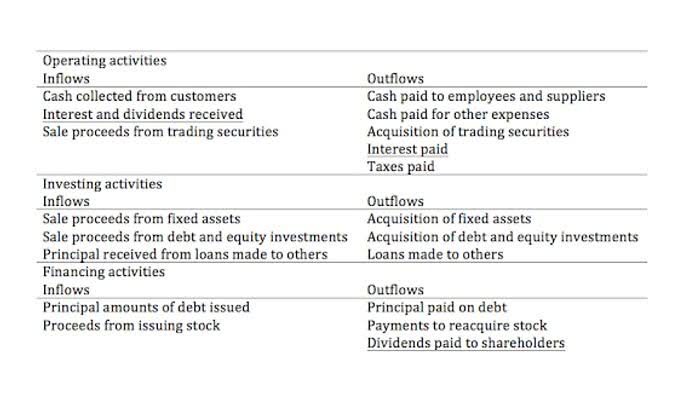
In the company’s balance sheet, construction in progress is most commonly found under the head of PP & E( Plant, Property & Equipment). In this blog, we will discuss the instances when construction in progress is used by the business. The international financial reporting standards dictate the recording of percentage completion in financial statements. Fixed assets under construction represent Construction in Progress (CIP) and are recorded in a similar named general ledger account. They remain in such an account until the assets are put in service, at which time the costs of the assets are transferred into respective property, plant and equipment accounts.
- The CIP procedures dictate the proper recording of construction costs in financial statements.
- Financial institutions must maintain records of customer identification documents, account opening documents, and transaction records.
- Under the IAS 11.8, if a construction contract relates to building two or more assets, each asset will be treated as a separate contract if specific conditions are fulfilled.
- Financial institutions typically verify customer identities using government-issued documents such as passports, driver’s licenses, or national ID cards.
- CIP, which stands for Capitalized in Progress, is one such term that plays a crucial role in financial reporting.
Process of Construction Work-in-Progress Accounting Journey
This percentage completion appropriation method is most common when a contract of delivering a large number of similar assets is made. For instance, it can be a contract to manufacture tires for a car manufacturing company. In this method, the number of units manufactured is divided by the total number of units to be manufactured. The most common capital costs include material, labor, FOH, Freight expenses, interest on construction loans, etc. Under the IAS 11.8, if a construction contract relates to building two or more assets, each asset will be treated as a separate contract if specific conditions are fulfilled.
What information is required for a Customer Identification Program (CIP)?
- In summary, the purpose of capitalizing assets in progress (CIP) is to ensure accurate financial reporting, adhere to the matching principle, assess project feasibility, and facilitate tax planning and compliance.
- Construction-in-Progress (CIP) accounting is indispensable for businesses striving to maintain accurate and comprehensive financial records.
- In addition to potentially wreaking havoc on your finances, these problems can also be a major red flag for sureties and lenders.
- These two phrases might be used interchangeably, or they might mean something else entirely to two different businesses.
- Construction work-in-progress accounting refers to the record-keeping of all expenditures that accrue in constructing a non-current asset.
- It is the approved bookkeeping method in the construction industry, viewing the complexities involved.
- In cost to cost method, all the cost incurred to the date is divided by the project’s total expected cost.
They should NOT be stored in the CIP account; otherwise, there is a considerable risk that expensable items will not actually be charged off for some time. Financial institutions must maintain accurate and up-to-date records of customer identification documents and transaction history, as per regulatory requirements. CIP plays a crucial role in maintaining the financial system’s integrity by ensuring that financial institutions conduct business with legitimate customers and comply with regulatory requirements. A software development company is creating a new application to be launched in the market.
- CIP allows for a more accurate portrayal of a company’s financial position and performance, providing stakeholders with the necessary information to make sound judgments.
- Instead of being ongoing expenses, they’re now considered assets that will provide value over time.
- Because the expansion is complete and in service, the equipment in this example will begin depreciating as other fixed asset accounts do.
- Our knowledgeable team has decades of experience managing construction company accounts, and you can feel confident that we will navigate your company’s specific situation with care and expertise.
Learn More About Tax Accountant Jobs
After the construction has been completed, the relevant building, plant, or equipment account is debited with the same amount as construction in progress. After the completion of construction, the company will record depreciation on the asset. However, the term ‘ construction under process’ is used when the company is making construction contracts.
Tracking Every Expense:

Technology can help streamline CIP processes through electronic identity verification, which uses digital methods to validate customer identification documents and data. By understanding the concept of CIP and its implications, businesses can effectively manage long-term projects, optimize resource allocation, and enhance their financial reporting practices. However, preparing accurate reports is not simple for construction companies whose work-in-progress assets are unique. Amid the construction progress, these assets are not usable as they require months or years for completion, complicating bookkeeping. That’s why it is better to track projects undergoing construction separately on a different balance sheet until completion.
Managing CIP accounts with others or even separately requires experience and proper knowledge. The basis for the effort expended can be labor hours, the material used, or machine hours. For instance, if a cement manufacturing company is expanding the manufacturing unit. It will use cement from its own inventory, therefore, debiting the inventory account. So, while items are booked when money changes hands with cash basis, items are booked when an invoice passes hands with accrual basis.
Do you own a business?

Once the building is completed and put into service, the costs recorded as CIP are transferred to the “Property, Plant, and Equipment” account. From that point forward, the building will be subject to depreciation over its useful life. Engaging an experienced CIP accounting team ensures meticulous record-keeping and accurate financial reporting throughout the construction journey. Construction in progress impacts financial analysis by providing insights into the amount of investment tied up in ongoing construction projects. It helps evaluate the capital expenditure, profitability, and overall financial health of the business. Depreciation is calculated using several methods, including straight-line, accelerated, and units of production.
An accountancy term, construction in progress (CIP) asset or capital work in progress entry records the cost of construction work, which is not yet completed (typically, applied to capital budget items). Normally, upon completion, a CIP item is reclassified, and the reclassified asset is capitalized and depreciated. Imagine a real estate development company embarking on a project to construct a commercial building. During the construction phase, the company incurs various costs, including materials, labor, permits, and architectural fees.
It includes direct costs, such as materials and labor, as well as indirect costs, such as permits, licenses, and supervision fees. By capitalizing these costs in progress, companies can more accurately reflect the value of the project and its impact on the financial statements. Construction-in-progress (CIP) is an account in which the costs incurred to build a fixed asset are stored. This account is only used while an asset is being constructed, after which the total cost is shifted to another fixed asset account. This account typically contains the costs of labor, materials, and overhead incurred during a construction project.

We aim to simplify the concept of CIP and present it in a user-friendly manner, providing practical examples and real-world scenarios to better illustrate its application. – Construction-in-progress and other accounts must be separate to minimize the hassle and keep records balanced. what is a cip account That’s why most companies often hire a CFO to manage their accounts and ensure their finances are clean and error-free. In addition to this content, she has written business-related articles for sites like Sweet Frivolity, Alliance Worldwide Investigative Group, Bloom Co and Spent.
